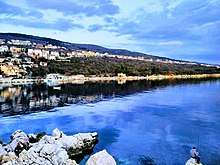Dramalj
Dramalj is a village in Croatia. It is part of the town of Crikvenica, extending from the neighborhood Crni mol to the tourist complex Kačjak. Dramalj has 1,485 inhabitants, most of whom are engaged in tourism and catering industry. A more intensive development of the village started back in the 19th century, following the tourism boom in the nearby Crikvenica area, as well as the rest of the Croatian Littoral.
Dramalj | |
|---|---|
Village | |
 Dramalj coast | |
| Country | |
| Population (2011)[1] | |
| • Total | 1,485 |
| Time zone | UTC+1 (CET) |
| • Summer (DST) | UTC+2 (CEST) |
| Area code(s) | 051 |
| Website | tzm-dramalj |
Nowadays, there are numerous private villas, newly built houses and suites, vacation resorts and hotels in Dramalj. Tourist complex Kačjak, named after the peninsula where it is located, offers bungalows and pavilions with total capacity of 500 guests as well as sport and recreational center equipped with all sport playgrounds, disco club, and a restaurant with a beautiful view to island Krk.
The village has several restaurants offering local specialties, as well as a post office and a clinic providing medical assistance to tourists. It is also home to the Dramalj Culture Hall, where traditional carnival feasts are held during the winter.
History

The village was settled only recently. Dramalj was first mentioned in the 18th century, when it was named Zagorje - Dramalj. In the beginning, it was a fishing port with olive groves, most of which were owned by the inhabitants of Tribalj valley.
There are ruins of an ancient Liburnian hill fort enclosed with a dry-stone dyke above Dramalj. Amphorae found around the Kačjak peninsula are evidence of an ancient Roman port located there at the time. Another one of Dramalj's landmarks is a "toš", an old olive press.
In the Austro-Hungarian times, Dramalj was part of Sveta Jelena County (St. Helen), which was founded in 1809. The parish house and the Church of St. Helen were built after 1812. The church was built on the foundations of an old chapel. G. Capovilla, a stone carver from Rijeka, made the altar in 1796. The construction of the church was financed by the parish and initiated by Mate Balas, then parish priest. The interior of the church was refurbished in the 19th century, the pulpit in 1837 and the main altar in 1845. The name of the village was soon after changed to Sveta Jelena. After the World War II, the former name Dramalj was restored.
The Culture Hall is located in the vicinity of the church. In 1939, the building was home to the first public library in Dramalj.
Climate
The North Adriatic, especially in this part of the Quarner Riviera enjoys the mild Mediterranean climate with some continental influence. The summers are sunny, dry and hot, while the winters are rainy and relatively mild with characteristic winds. The average annual air temperature is 14.2 °C. The coldest month is January, while the hottest one is July.
Average cloud cover in Dramalj is 0.51 (5.1 tenths of obscured sky), varying from 0.33 to 0.62. Hence, the insolation (according to Frejka) is approximately 2,500 hours a year, considerably higher than in some famous Swiss health resorts. Average annual relative humidity is 70%, while the peak rainy period is in October and November. Air pressure averages 761.8 millimetres of mercury (1,015.6 hPa).
Bora and jugo are predominant winds, while Ostro, maestral and levant) blow less often. Bora typically blows from November to February, peaking in strength in January, while jugo is most frequently experienced from May to August with the average maximum in July. Ostro, a southern wind, reaches its maximum in November. A particular climatic feature is the so-called "kalma", i.e. absolutely calm weather without any wind.
The soil in Dramalj area is mostly porous karst (limestone). The see is shallow even at a considerable distance from the coast. Wave strength in minor, allergens in air scant, while the salt and ozone content in the air is increased with minimal aerobic pollution.
The area features all climatic and bioclimatic conditions favorable for the development of thalassotherapy and health tourism.
Today

Dramalj is a popular location for summer vacation. Tourists from all over Europe come to enjoy the beaches and culture. Attractions include a motorized train for children, many cafes, and restaurants which offers Croatian cuisine and seafood.[2] There is also a supermarket located in town.
See also
References
- "Population by Age and Sex, by Settlements, 2011 Census: Dramalj". Census of Population, Households and Dwellings 2011. Zagreb: Croatian Bureau of Statistics. December 2012.
- http://www.domino-dramalj.com/restaurant.html
External links
| Wikimedia Commons has media related to Dramalj. |
- Tourist association of Dramalj (in Croatian)